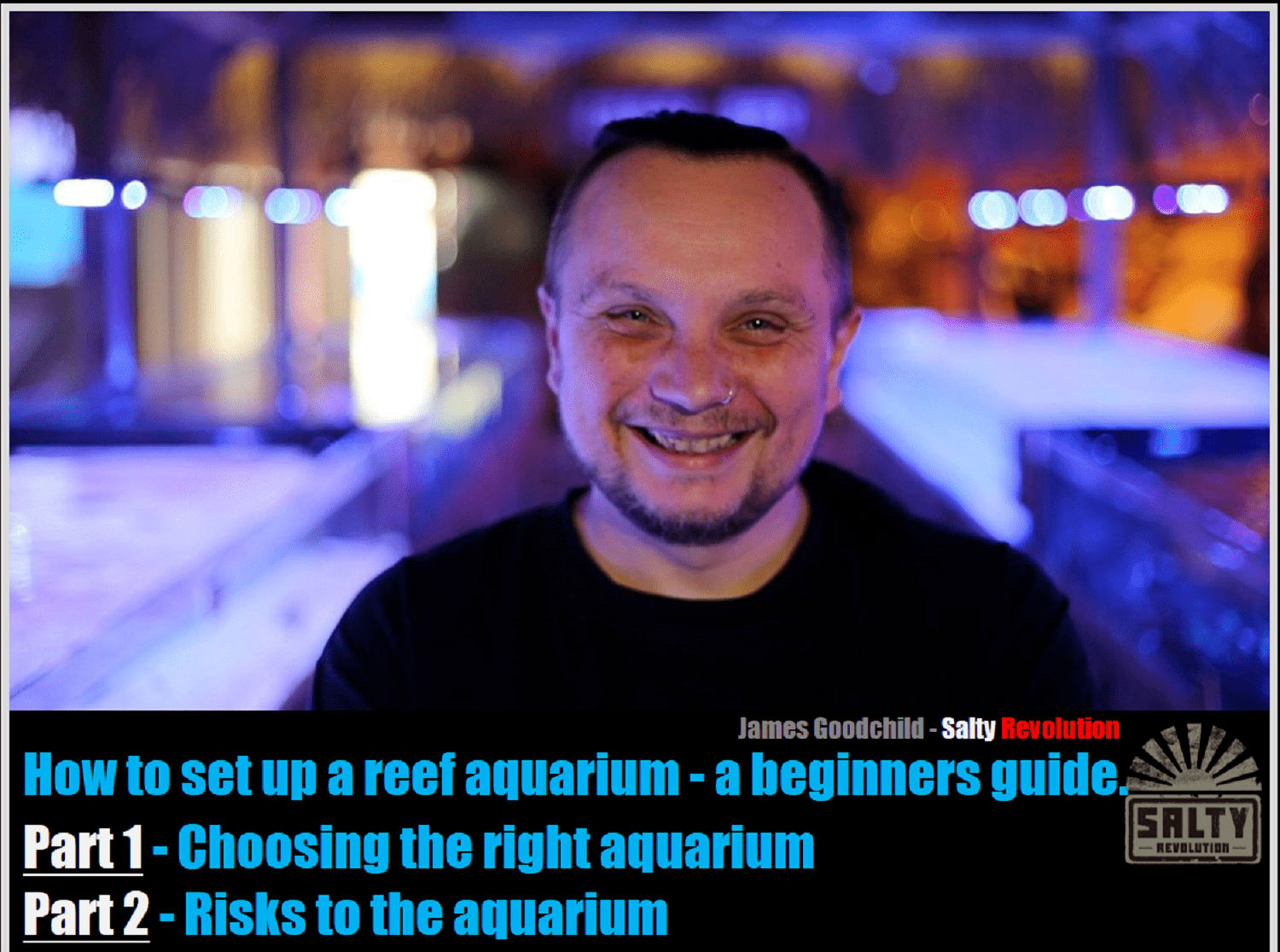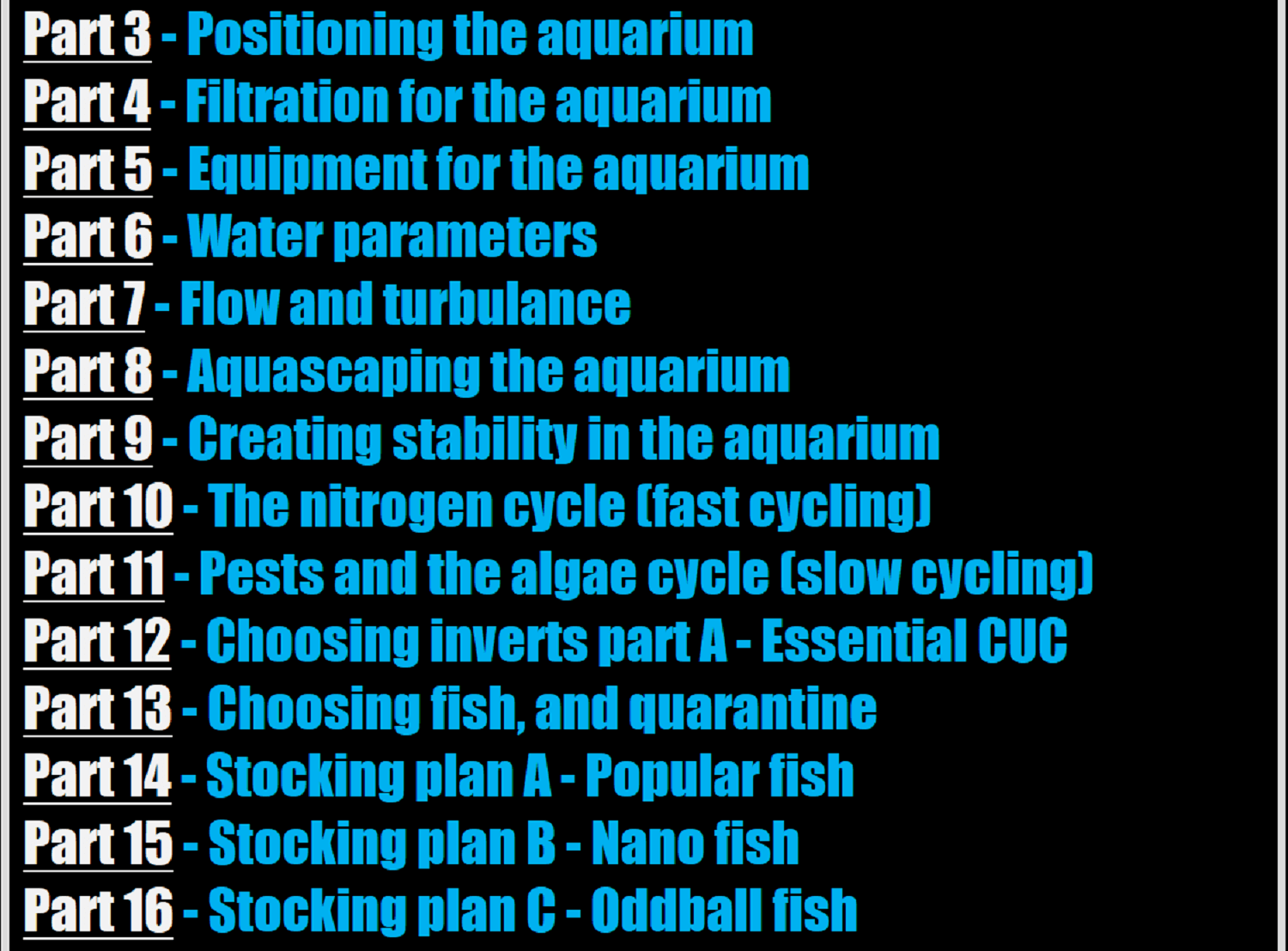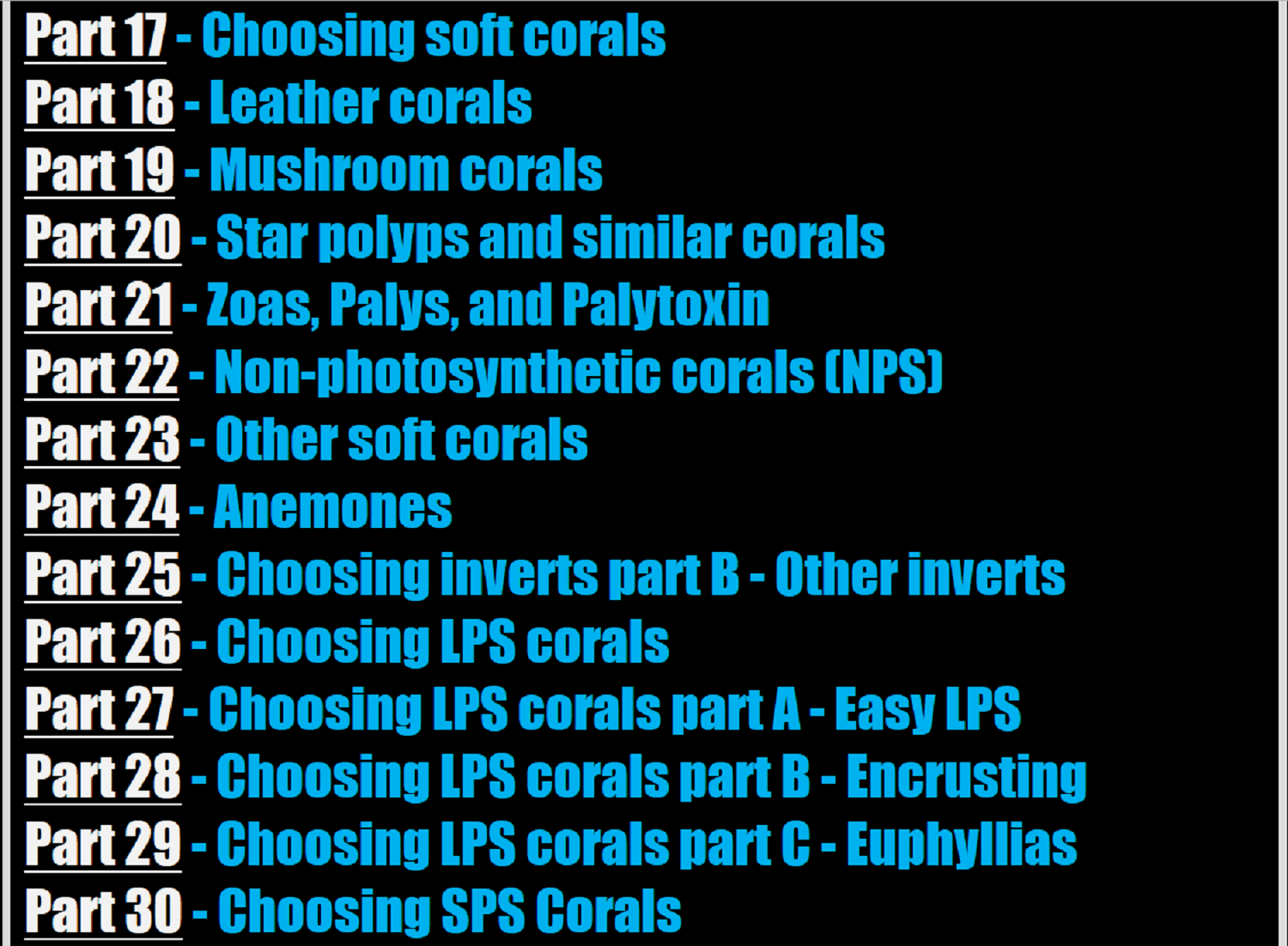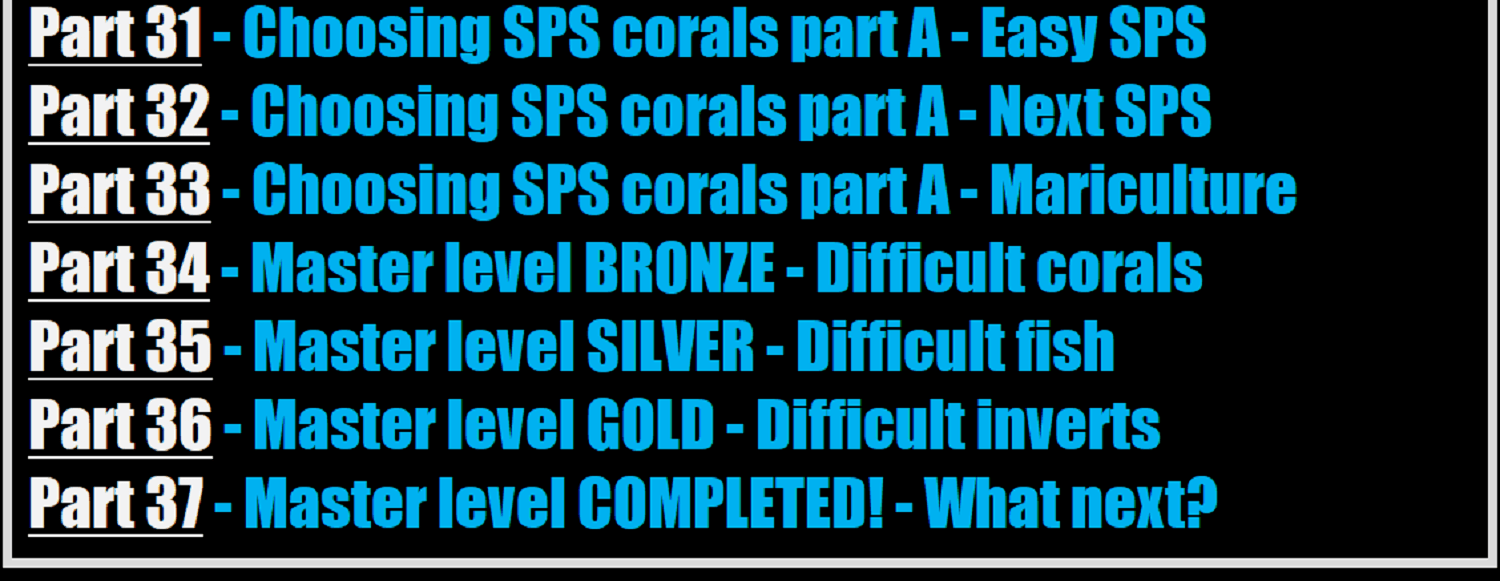How to set up a reef aquarium - PART 5 - Equipment for the aquarium
How to set up a reef aquarium - part 5 Equipment for the aquarium - by James Goodchild at Salty Revolution August 2022.
Introduction to setting up a reef aquarium, by James Goodchild at Salty Revolution.
Sign up to our VIP mailing list below, so you don’t miss out on all this free advice. Our VIP mailing list is free to join, no membership costs, you can unsubscribe anytime you want, we only need your name and the email address you’d like our updates sent to. We don’t share your details with anyone else either. You also get info on new shipments, special VIP first peek options, VIP offers, and even special VIP priority store opening days, etc. You might save yourself a fortune by joining, and if it’s not for you then you can always unsubscribe whenever you want. Although I doubt you’d want to!
PART 5 - Equipment for the aquarium
BASIC ADVICE
At a most basic level you need heat, light, and flow. Choose appropriate sized return pumps and powerheads. Glass heaters are preferable, especially if ran through a heating controller. For fish only lighting doesn’t matter too much, but, for corals get the best lights you can afford.
JAMES SAYS
The best advice on equipment is to keep it simple. The less reliant on equipment your system is, the less likely it is that when something inevitably breaks it’s less likely to be catastrophic. Similarly, and especially so on larger tanks, double up on equipment where you can. Rather than rely on one big return pump, use two smaller ones if possible. Always have more than 1 heater unless it’s a nano tank, and running two powerheads instead of one is a great safety measure. That way when one piece of equipment jams, blocks, or breaks, you’re not left completely helpless. Also remember to check and maintain the equipment. Whenever you feed or look at your tank, try to get into the habit of just glancing at each pump outlet and check they are working correctly. At least once a month carefully inspect heaters for condensation inside them (don’t lift hot heaters out of the water where they may then explode, and watch out for electrical shocks from faulty heaters too).
Heating - Personally I favour glass heaters. It is far easier to check they are not faulty than it is with titanium heaters. They’re also less expensive so you can belt and bracers the job with several as back ups to each other, and a spare one just in case. In terms of heating power the simple rule I use is 1 watt per litre, plus an extra heater. So on a 200 litre tank you would want 200 watts of heating, so use two 100 watt heaters, plus a third one in there so if one fails there is still two to do the job. In very cold rooms go to 2 watts per litre. Bear in mind they only use electric when on and heating so adding more heaters doesn’t use any more electric. I’d also recommend splashing out on a temperature controller too. The DD ones are very good, but, don’t like getting wet. The Aquamedic ones cost a bit more but tend to last a bit longer. Either are a good buy. Avoid budget brand heaters like the plague, they tend to break often and in the long run easily costs you more. Most mid range heaters are fairly similar, but, if you don’t mind paying a bit more get the Oase ones. By far the best heaters I have ever used.
Lighting for fish - If it’s fish only, with maybe a few leather corals, then if you want the fish to look amazing use Kessils, without a doubt the best light for fish. On a budget a simple T5 florescent or two will do the job. Avoid budget LED’s they are usually pretty feeble.
Lighting for corals - For corals then whilst halides and T%’s are best for farming growth, and can also be useful on SPS tanks, especially larger tanks, for most people you’re looking at LED’s and if you’re even remotely serious about corals buy Hydras. The Hydra 32HD is an amazing piece of kit, that can light up to a 3ft or 4ft spread if you raise it up a bit. The Hydra 64HD is great for SPS tanks, but, for everyone else use 32’s. If you can’t afford new Hydra 32’s then look at secondhand ones, or the older models such as the 26 or 52, but, bear in mind that a 26 will only really light about 2ft. So if you’ve got a 3ft tank then one new 32 may cost less than two secondhand 26’s. Even the old Vega’s are still a worthwhile light, and occasionally available cheaply secondhand. I’d recommend if possible sticking to Hydras, and if on a budget a secondhand Hydra is preferable to a new cheaper light. At the risk of sticking my neck out a bit I’d say avoid Prime’s which can be a bit feeble in light output, and personally I’d never have another Radion after having had so many of them overheat and/or catch fire on me. Maybe I got a bad batch, maybe they’ve improved, personally though I’d get the Hydras.
Return pumps - Yes you can get some very fancy DC return pumps and I have tried and tested many brands of them. Having said that I’d still favour an AC return pump every time. An AC motor has more torque than most equivalent DC pumps. They are generally less affected by head pressure and blockages, and are generally more reliable too. On a sensible budget buy Eheim, they just never break and worth every penny. On larger tanks look at some of the marine safe pond pumps from well known pond equipment manufacturers, just check it’s safe in saltwater as not all are. If you have no budget concersn, or, you simply want the very best then buy Abyzz, nothing is more reliable, quieter, or more powerful for it’s power consumption than an Abyzz pump. They are the Rolls Royce of aquarium pumps. You may wince at the price, but, if you can afford the very best then get it, I have not yet many anyone that has bought an Abyzz pump and regretted it, and very few people that then go on to buy anything other than Abyzz ever again. On very large tanks, especially taking into running costs, they may work out very cost effective too.
Powerheads / wavemakers - You can get all sorts of fancy (and expensive) wavemakers that will do all sorts of fancy tricks. In reality though, it’s not really that useful. Really you just want to reliably move lots of water consistently. Inexpensive DC powerheads are pretty good generally, and in larger tanks AC powered ones are even better. I’m a big fan of the Hidom range of powerheads,, they are amazingly well priced, and reliable as anything. I even tried breaking one on purpose in testing by feeding small rocks and sand into it, it was fine. A super reliable, cost effective and truly brilliant range of powerheads that go all the way up to 48,000LPH, awesome! If you don’t mind spending a few quid and want something fancier than by far and the best are the Maxspect Gyres. They are immensely powerful, and can do many wonderful things. Choose the model carefully though as you may find that even on minimum power it is too powerful for what you need. Generally work out which model of Gyre you think you want and then buy the smaller model than that, you might still only run it on minimal power, they are a fantastically powerful piece of kit. You will see cheaper copies of the Gyre about, personally you’re better off spending a bit more and getting a Gyre, or buying a secondhand Gyre rather than a new copy. There are many other brands of DC powerheads with all sorts of gimmicky features. In my experience they often suffer from death if the controller gets damp, and occasionally jam or blow up their powerpacks. I’d say go Hidom if the tank can handle the flow (they don’t make many small ones), or, cheap and cheerful DC powerhead, or splash the cash and get a Gyre. Personally I’d take the Hidom’s.
UV - Despite the commonly held belief that UV can control or help control disease in a marine aquarium it simply cannot. It will make your water clearer though, and on larger tanks that is particularly worth considering, but, not essential.
Ozone - On very large system over 2,000 litres run Ozone. on systems 1,000 to 2,000 litres consider it. On anything under 1,000 litres then probably don’t bother. Ozone is not something that scales down well. On giant tanks it is utterly fantastic, on smaller tanks it works out quite expensive for not much benefit.
Reactors - We don’t bother using them except for Ozone. Reactors look cool, but, in reality a mesh basket will often do the same job if positioned well at a fraction of the cost and easier to maintain too.
Roller filters - As with Ozone they can be brilliant on large multi thousand litre systems. The smaller scaled down versions for tanks under 1,000 litres aren’t great. If you do want one then buy a secondhand one. There is usually no shortage of people that have bought one, used it, then decided to sell it. There’s a reason for that. simply don’t bother.
Dosing pumps - Great on big complicated SPS systems, and mostly used on small mixed reef systems where they often do more harm than good. Great for dosing coral food, but, unless you have a A level chemistry stick to adjusting element dosing manually as that way you will learn more about how your tank works and have better success as a result.
Calcium reactors - Essential on large SPS dominated systems. But, as with Ozone it doesn’t scale down well, so on systems under 1,000 litres there are probably better solutions. Unnecessary for 99% of hobbyists.
Electronic control systems - They look like a fantastic idea, and they can certainly do many wonderful things. They are usually extremely reliable too. However, if they do go wrong it can be catastrophic. Although it’s not something that happens often, bear in mind if it does happen it can shutdown all your equipment, and that can be very bad very quickly. On large complex systems they are almost essential, but, unless you have to have one, then you’re probably better off with more simple protection measures such as; a fire alarm, flood alarm, temperature alarm, and webcam.
Other latest gadget must haves - Every so often some new piece of revolutionary piece of kit comes onto the market. It sounds amazing, and 9 times out of 10 it isn’t. Generally if no one was using one 2 years ago, then bear in mind what you might be buying is the fishkeeping equivalent of a Sinclair C5, or an electric tin opener. Very cool at one specific task which is probably of no actual use in the real world. We do love a gadget though.
Why no skimmer? (This was covered in the last part, but, repeated here). A skimmer can be a very useful piece of kit, however they can be fiddly to adjust and sooner or later may end up out of adjustment, blocked, or stop working altogether. If your system is reliant on the skimmer this can be very bad news indeed. However the main reason for not using a skimmer is that a skimmer removes most of the free floating life in the aquarium. All these tiny free floating algae and animals do a useful job in processing nutrients, provide a food source for the corals, and also form the start of the food web providing some natural food for the fish and other small animals in the tank.
DISCLAIMER
All views and reviews are solely my own from my own personal experience. We have not received any payments or incentives for mentioning any of the brands here, and this was written independently and without their prior knowledge or approval. We stock very little dry goods, and do not currently stock any of the brands mentioned. We specifically avoid stocking electrical equipment as much as possible so that we can provide truly honest and independent advice and recommendations. All of the brands mentioned are widely available online.
That’s all for PART 5, in PART 6 we look at water parameters.
Links
Sign up below so you don’t miss future parts of this series.
Salty Revolution; Facebook, YouTube, Instagram, and email us.
James Goodchild
Salty Revolution



















A beginners guide to setting up a reef aquarium.